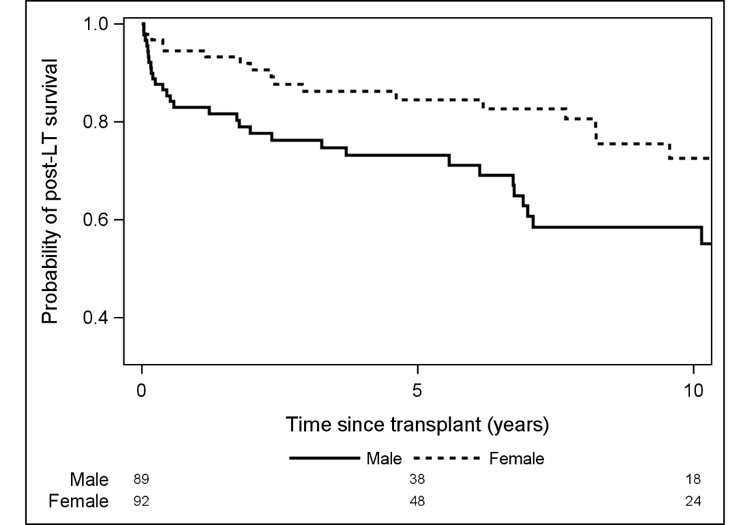Offspring to Parent Living Donor Liver Transplantation: An Analysis of the A2ALL Database
R. A. Choudhury1, H. J. Braun2, J. D. Grab2, J. L. Dodge2, H. B. Moore1, D. Yoeli1, J. J. Pomposelli1, T. Nydam1, N. L. Ascher2, E. A. Pomfret1, J. P. Roberts2
1Department of Surgery- Division of Transplantation Surgery, University of Colorado Hospital, Aurora, CO, 2Department of Surgery- Division of Transplantation Surgery, University of California, San Francisco, San Francisco, CA
Meeting: 2020 American Transplant Congress
Abstract number: 364
Keywords: Allorecognition, Living donor, Living-related liver donors, Multivariate analysis
Session Information
Session Name: Liver: Living Donors and Partial Grafts I
Session Type: Oral Abstract Session
Date: Saturday, May 30, 2020
Session Time: 3:15pm-4:45pm
 Presentation Time: 3:39pm-3:51pm
Presentation Time: 3:39pm-3:51pm
Location: Virtual
*Purpose: Recently, there have been concerns regarding inferior graft survival following offspring to parent kidney transplantation due to issues related to alloimmunity during pregnancy. It remains unclear whether this phenomenon can also be observed during living donor liver transplantation (LDLT). The purpose of this study was to determine the impact of offspring to parent LDLT.
*Methods: A retrospective prospective analysis utilizing the Adult Living Donor Liver Transplantation (A2ALL) Database was completed. From January 1, 1998 to January 1, 2017 a total of 1,064 LDLTs were observed. Three donor categories were created 1) offspring donor, 2) related-non offspring (RNO) donor, and 3) Non-related non-offspring donor (NNO). Graft survival (graft loss event defined as death or retransplant) was estimated using Kaplan-Meier methods and analyzed using Cox proportional hazards modeling.
*Results: There were a total of 373 offspring donors, 325 RNO, and 366 NNO donors. Offspring donors were significantly younger than NNO and RNO donors at time of donation (29yrs. vs. 41yrs vs 42yrs, P<0.001). Although 10-yr post-LT graft survival was similar for recipients of offspring (58.5%, 95% CI 51.5-64.9), NNO (60.2%, 95% CI 53.3-66.4, p=0.91) and RNO (60.3%, 95% CI 52.9-66.9, p=0.21) donors, controlling for relevant donor/recipient characteristics with multivariate analysis showed offspring donation was associated with increased risk of graft loss (HR= 1.42, 95% CI: 1.00-2.02, P=0.049). Gender-subgroup analysis demonstrated male offspring donor to female parent recipient was associated with inferior graft survival relative to female offspring donor to female parent donation (10 years graft survival: 72.5% (95% CI 58.2-82.7) vs. 58.5% (95% CI 45.1-69.8), P=0.05). Observed rates of Clavien grade 4 complications were similar (16.2% vs. 16.3% vs. 18.9%, P=0.96) for offspring to parent LDLT compared to NNO and RNO, respectively.
*Conclusions: Offspring to parent donation is associated with inferior long-term graft survival, an effect which is potentiated when the donor gender is male. It remains unclear to what extent pre-formed antibodies from pregnancy may mediate this finding. As such, cross-matching potential offspring to parent pairing for LDLTs may be warranted.
To cite this abstract in AMA style:
Choudhury RA, Braun HJ, Grab JD, Dodge JL, Moore HB, Yoeli D, Pomposelli JJ, Nydam T, Ascher NL, Pomfret EA, Roberts JP. Offspring to Parent Living Donor Liver Transplantation: An Analysis of the A2ALL Database [abstract]. Am J Transplant. 2020; 20 (suppl 3). https://atcmeetingabstracts.com/abstract/offspring-to-parent-living-donor-liver-transplantation-an-analysis-of-the-a2all-database/. Accessed December 29, 2025.« Back to 2020 American Transplant Congress

